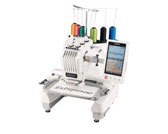PR650e/PR650eC
FAQs & Troubleshooting |
How do I thread the machine? (Threading the upper thread)
>Moving and threading a selected needle bar
Upper threading
Use embroidery thread to thread the needle bars in order, starting with needle bar 1.
When threading the upper thread, carefully follow the instructions. If the upper threading is not performing correctly, the thread may break or become tangled, causing the needle to bend or break.
It is recommended that rayon or polyester embroidery thread be used (120 den/2, 135 dtex/2, 40 weight).
- The path that the embroidery machine should be threaded is indicated by a line on the machine. Be sure to thread the machine as indicated.
-
Touch
 →
→  →
→  →
→  in order to view a video of the operation on the LCD.
in order to view a video of the operation on the LCD.
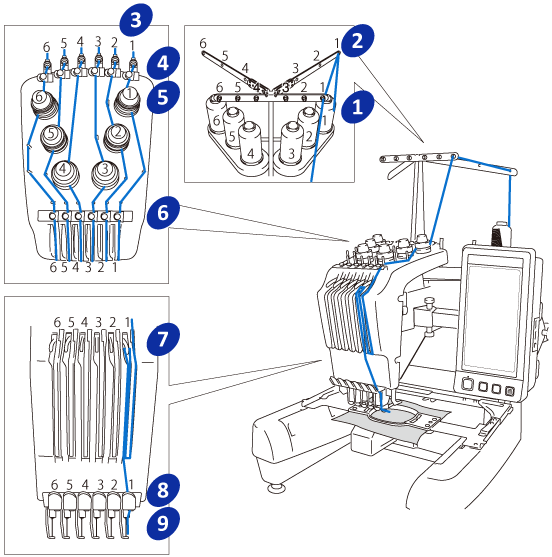
(1) Placing a spool on the spool pin and passing the thread through the thread guide
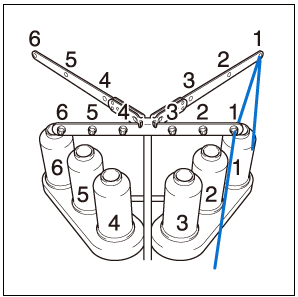
The numbers indicate the thread path for each of the numbered needle bars.
Be very careful to correctly thread the needle bars.
-
Place on spool pin 1 the spool of thread with the color specified for needle bar 1.
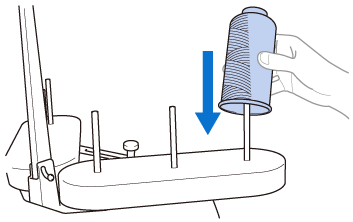
- Make sure that the spool stand is opened in the shape of a V.
- When using small spools of thread, be sure to place the included spool mat on the spool pin before placing the spool on the pin.
- Use spool cap on all spools of thread shorter than the height of the spool pin.
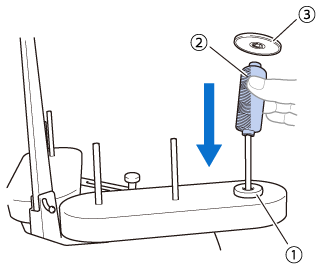
(1) Spool mat
(2) Small spool
(3) Spool cap
-
Pass the thread through the number 1 hole in the thread guide just above the spool, and then pass the thread through the number 1 hole in the thread guide toward the front of the machine.
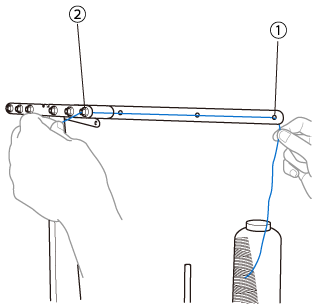
(1) Number 1 hole in the thread guide
above the spool(2) Number 1 hole in the thread guide
toward the front of the machine
(2) Pass the thread through the thread guide and the thread tension disc
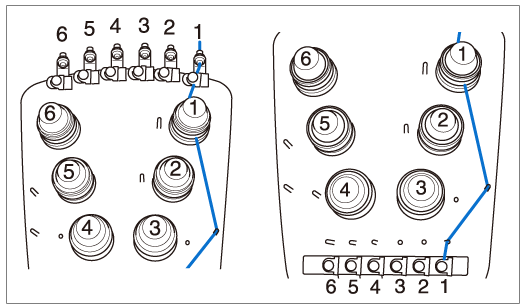
The numbers indicate the thread path for each of the numbered needle bars.
Be very careful to correctly thread the needle bars.
-
Pass the thread through the hole in the number 1 upper thread guide. Pass the thread toward you from the inside of the thread guide.
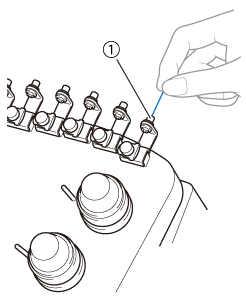
(1) Hole in upper thread guide -
Pass the thread through the number 1 upper thread guide. Hold the thread with both hands, and then pass it under the guide from the right.
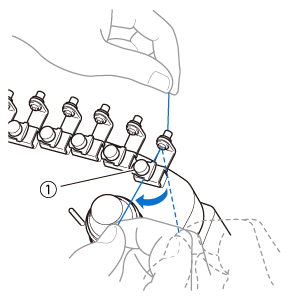
(1) Upper thread guide -
Wind the thread clockwise once around the number 1 thread tension disc.
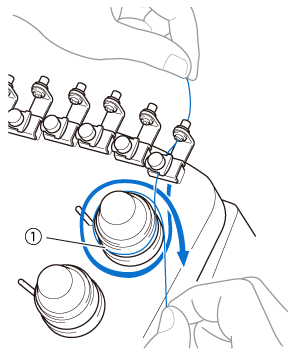
(1) Thread tension disc
- All thread tension discs are threaded in clockwise direction.
-
Make sure that the thread is securely caught in the thread tension disc and passed correct thread guide pins.
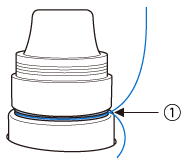
(1) Pass around here.
-
Pass the thread along the thread path indicated on the machine, and then pass it under the number 1 middle thread guide plate.
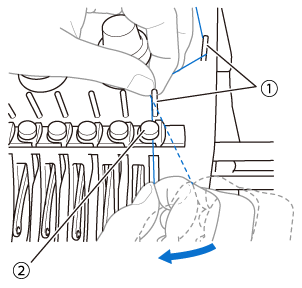
(1) Thread guide pin
(2) Middle thread guide
The path from the upper thread guide around the thread tension disc and to the middle thread guide (steps 5 through 6) may differs depending on the spool number. Passing the thread through the thread guide pins is designed to prevent the thread from becoming tangled. Be sure to follow the thread path indicated on the machine.
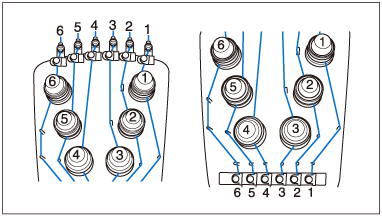
(3) Pass the thread through the thread take-up lever and the needle bar thread guide
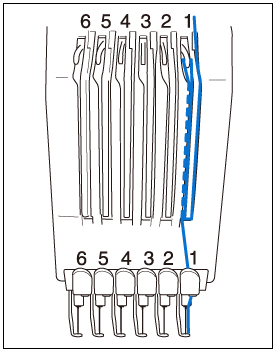
The numbers indicate the thread path for each of the numbered needle bars.
Be very careful to correctly thread the needle bars.
-
Pass the thread along the number 1 slot to pass it through the number 1 take-up lever hole from right to left.
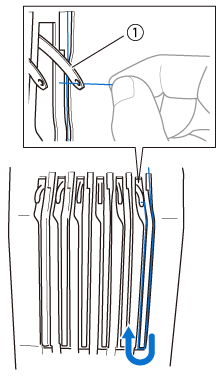
(1) Thread take-up lever
-
Pass the thread down through the slot to the lower thread guide, and then through the hole in the number 1 lower thread guide.
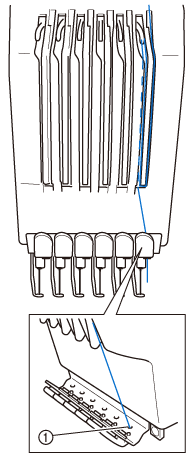
(1) Hole in lower thread guide
-
Use the included threader to pass the thread into the number 1 needle bar thread guide.
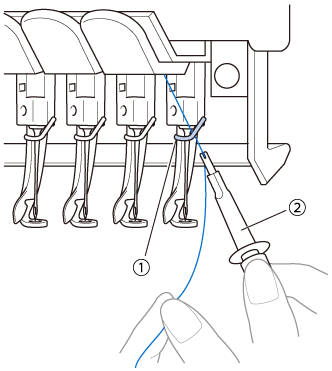
(1) Needle bar thread guide
(2) Needle changing tool (Threader)
Threading the needle
Use the automatic needle-threading mechanism to thread the needle.
Touch ![]() →
→ ![]() →
→ ![]() →
→ ![]() in order to view a video of the operation on the LCD.
in order to view a video of the operation on the LCD.
-
Press the automatic needle-threading button.
>> The hook on the automatic needlethreading mechanism passes through the eye of the needle.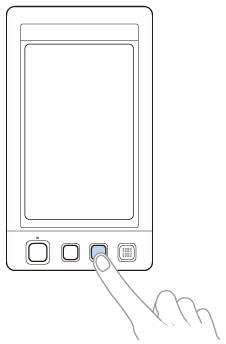
- If the needle is not fully inserted, the hook of the automatic needle-threading mechanism will not pass through the eye of the needle during automatic needle threading, and the hook may bend or the needle cannot be threaded.
- If the hook of the automatic needlethreading mechanism is bent or damaged, contact your authorized dealer.
- While the hook of the automatic needle-threading mechanism is passed through the eye of the needle, do not rotate the handwheel, otherwise the automatic needle-threading mechanism may be damaged.
- To avoid damage, the automatic needlethreading mechanism may return to the back position when you turn the handwheel.
- The automatic needle-threading mechanism can thread one needle at the sewing position. When this mechanism is used, be sure that the needle bar that you want to thread is positioned as the sewing position, otherwise the automatic needlethreading mechanism cannot be used at the particular needle.
-
Pull out about 150 mm (6 inches) of thread. Allow thread to relax and eliminate any stress on the thread. Then, as shown in the illustration, pass the thread under the fork of the automatic needle-threading mechanism from the right, and then catch the thread with the hook that passes through the eye of the needle.
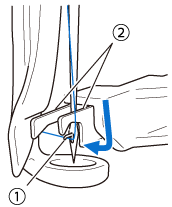
(1) Hook
(2) Fork
When catching the thread with the hook, be careful that the thread does not become loose.
-
Pass the thread under the guide on the presser foot.
>> Make sure that the thread securely passes through the notch in the guide on the presser foot.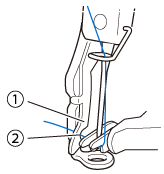
(1) Guide on presser foot
(2) Notch in guide on presser foot
-
Securely pass the thread through the groove in the thread cutter, and then lightly pull the thread to cut it.
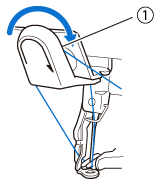
(1) Groove in thread cutter - If the thread is not correctly passed through the groove in the thread cutter, the message “Wiper error” appears and the needle cannot be threaded. Be sure to securely pass the thread through the groove.
- If enough thread is not pulled out, the thread cannot be pulled through the thread cutter.
-
Press the automatic needle-threading button.

>> The threader moves back away from the needle. The thread is pulled through the needle eye.
The wiper comes out and catches the thread between the needle and the threader.
The threader goes back to the original home position.
This completes the upper threading for needle bar 1.
Thread the remaining needle bars in the same way.
- If the needle bar to be threaded is not moved to the embroidering position, the needle cannot be threaded with the automatic needle-threading mechanism.
- For the remaining needle bars, perform the operation described in the next section "Moving and threading a selected needle bar" to move the needle bar to the embroidering position before trying to thread the needle .
- If the thread is not taut, it may come out of the thread tension disc.
- After upper threading is finished, check again to make sure that the thread is correctly passed into the thread tension disc.
Moving and threading a selected needle bar
Moving and threading a selected needle bar to the embroidering position
You can move and thread a selected needle bar to the embroidering position at any time.
-
Touch
 .
.
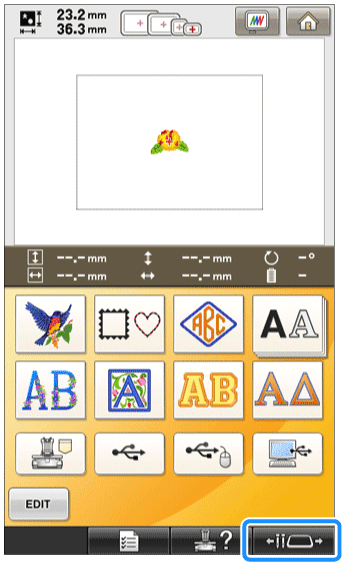
>> The needle bar move screen appears.
-
Touch the key for the needle bar that you wish to move or thread.
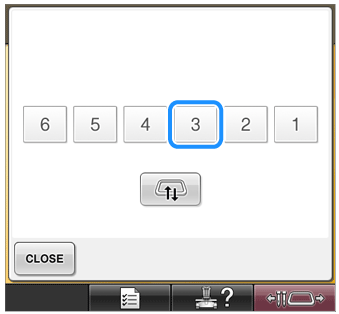
>> The selected needle bar moves to the position of embroidery.
-
Press the automatic needle-threading button while the needle bar move screen appears.

-
Touch
 to return to the previous screen.In the embroidering screen, a blue frame appears around the thread information box of the selected needle bar.
to return to the previous screen.In the embroidering screen, a blue frame appears around the thread information box of the selected needle bar.
(1) This needle bar is selected. (The blue frame appears around the thread information.)
Moving the needle bar to be threaded to the position of embroidery in the embroidering screen
You can move the needle bar in the embroidering screen.
-
Touch the key for the needle bar that you wish to thread.
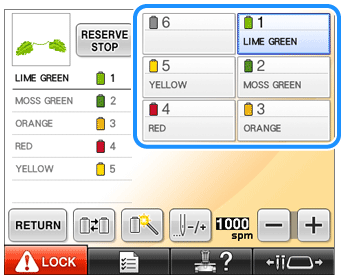
>> The selected needle bar moves to the embroidering position.
When changing one of the upper thread colors, it is easy to re-thread by cutting the thread currently being used between the spool and the thread guide above the spool. Place the new spool on the spool pin and tie the end of the new thread to the end of the previous thread. Then pull the thread through to the needle.
